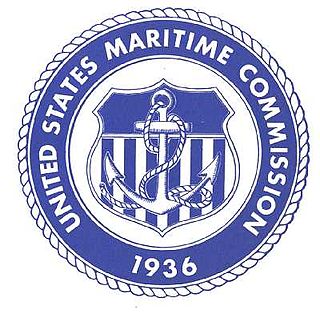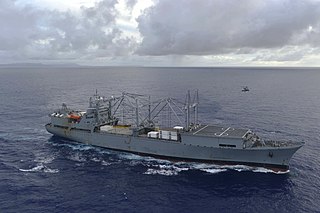
The United States Merchant Marine refers to either United States civilian mariners, or to U.S. civilian and federally owned merchant vessels. Both the civilian mariners and the merchant vessels are managed by a combination of the government and private sectors, and engage in commerce or transportation of goods and services in and out of the navigable waters of the United States. The Merchant Marine primarily transports cargo and passengers during peacetime; in times of war, the Merchant Marine can be an auxiliary to the United States Navy, and can be called upon to deliver military personnel and materiel for the military. Merchant Marine officers may also be commissioned as military officers by the Department of Defense. This is commonly achieved by commissioning unlimited tonnage Merchant Marine officers as Strategic Sealift Officers in the United States Navy Reserve.

The National Defense Reserve Fleet (NDRF) consists of ships of the United States of America, mostly merchant vessels, that have been "mothballed" but can be activated within 20 to 120 days to provide shipping during national military emergencies, or non-military emergencies such as commercial shipping crises.

The United States Maritime Administration (MARAD) is an agency of the United States Department of Transportation.
Its programs promote the use of waterborne transportation and its seamless integration with other segments of the transportation system, and the viability of the U.S. merchant marine. The Maritime Administration works in many areas involving ships and shipping, shipbuilding, port operations, vessel operations, national security, environment, and safety. The Maritime Administration is also charged with maintaining the health of the merchant marine, since commercial mariners, vessels, and intermodal facilities are vital for supporting national security, and so the agency provides support and information for current mariners, extensive support for educating future mariners, and programs to educate America's young people about the vital role the maritime industry plays in the lives of all Americans.

The United States Maritime Commission (MARCOM) was an independent executive agency of the U.S. federal government that was created by the Merchant Marine Act of 1936, which was passed by Congress on June 29, 1936, and was abolished on May 24, 1950. The commission replaced the United States Shipping Board which had existed since World War I. It was intended to formulate a merchant shipbuilding program to design and build five hundred modern merchant cargo ships to replace the World War I vintage vessels that comprised the bulk of the United States Merchant Marine, and to administer a subsidy system authorized by the Act to offset the cost differential between building in the U.S. and operating ships under the American flag. It also formed the United States Maritime Service for the training of seagoing ship's officers to man the new fleet.
SS Charles Bulfinch was a Liberty ship built in the United States during World War II. She was named after Charles Bulfinch, an American architect. Bulfinch is best known for his designs of the Massachusetts State House, and the wings and central portion of the US Capitol.

USS Sherburne (APA-205) was a US Navy Haskell-class attack transport, built and used during World War II. She was of the VC2-S-AP5 Victory ship design type. Sherburne was named for Sherburne County, Minnesota. She was later converted and renamed USS Range Sentinel (AGM-22), a missile range instrumentation ship.

USS Kennebec (AO-36) was originally the SS Corsicana, a Kennebec class T2 tanker that was built by Bethlehem Sparrows Point Shipyard in Sparrows Point, Maryland. It was delivered to Socony-Vacuum Oil Company on 8 August 1941. It was purchased by the United States Navy on 13 January 1942 and renamed Kennebec.

The TS Golden Bear is the training ship of the California State University Maritime Academy (CSUMA), a campus of the California State University. The first training ship of the then–California Nautical School was known as the Training Ship California State, then as the T.S. Golden State. Since then, there have been three ships to bear the name T.S. Golden Bear.
USTS Empire State VI (T-AP-1001), callsign KKFW, IMO number 5264510, is a troop ship of the United States Navy and training vessel of the United States Maritime Service.

TS State of Maine is the training ship of the Maine Maritime Academy.

USS Crescent City (AP-40/APA-21) was the lead ship of the Crescent City-class attack transports that served with the US Navy during World War II. The ship was built as the cargo and passenger liner Delorleans for the Mississippi Shipping Company's Delta Line. After brief commercial operation the ship was among 28 vessels requisitioned in June 1941 for the Navy and the Army. The Navy renamed the ship Crescent City, a popular nickname for New Orleans, Louisiana, upon commissioning 10 October 1941. The ship was decommissioned and laid up in 1948 before being loaned to the California Maritime Academy to serve as a training ship 1971–1995 and then transferred to a foundation in a failed art colony project. The ship left California for Texas scrapping in 2012.

The Type C4-class ship were the largest cargo ships built by the United States Maritime Commission (MARCOM) during World War II. The design was originally developed for the American-Hawaiian Lines in 1941, but in late 1941 the plans were taken over by the MARCOM.

SS Equality State (T-ACS-8) is a crane ship of the United States Navy. The ship is named for the state of Wyoming, which is also known as the Equality State.

USTS Kennedy(T-AK-5059), callsign KVMU, IMO number 6621662, is a former commercial freighter and a current training vessel of the United States Maritime Service.
The Type C7 ship(Lancer Class) is a United States Maritime Administration (MARAD) designation for a cargo ship and the first US purpose-built container ship. The vessels were constructed in US shipyards and entered service starting in 1968. As US-built ships they were Jones Act qualified for shipments between US domestic ports. Under the Jones Act domestic US maritime trade is restricted to US-built and flagged vessels of US owners and manned by predominantly US-citizen crews. The last active Lancer container-configured ship was scrapped in 2019. Lancers of the vehicle Roll-on/Roll-off (RO/RO) configuration remain held in the Ready Reserve Force, National Defense Reserve Fleet and the US Navy Military Sealift Command. All are steam powered.

The Type C6 ship is a United States Maritime Administration (MARAD) designation for a container ship developed during the transition years from moving goods by breakbulk cargo to containerization. The Type C4 ships Mariner class, arranged with its house/engine-room in the center of the vessel with cargo hatches at 4 forward and 2 aft, was very successful. Eleven of these Mariner ships were converted into Type C6 container ships, and eight vessels were new built. As of November 2020 only three C6 ships, the converted C4s, are extant. All three are crane ships in the National Defense Reserve Fleet.
The MV Cape Rise (T-AKR-9678), formerly Saudi Riyadh, formerly Seaspeed Arabia, is a roll-on/roll-off (RO/RO) and container ship built in 1977.

The Type C5 ship is a United States Maritime Administration (MARAD) designation for World War II breakbulk cargo and later a container ship for containerization shipments. The first type C5-class ship was a class of ships constructed and produced in the United States during World War II. The World War II C5-class ship was dry bulk cargo ship built by Bethlehem Steel in Sparrows Point, Maryland. Bethlehem Steel built eight ships in this bulk cargo class and four orders were canceled. The C5-class ship has a 24,250 DWT and was 560 feet (170 m) long. The C5 was mainly used as iron ore carriers. The C5 was needed to replace other ships that sank during World War II. First in her class was SS Venore, USMC #1982, delivered on 20 July 1945. The Type C5-class ship designed to fill the need to move iron ore from Santa Cruz, Chile, to Sparrows Point, Maryland, through the Panama Canal, a round-trip of 8,700 nautical miles . Post World War II, four ships were given C5 class type C5-S-78a, these were roll-on/roll-off container ship built by Ingalls Shipbuilding, Inc. of Pascagoula, Mississippi and operated by the Moore-McCormack Lines. The C5-S-78a had a deadweight tonnage of 16,000 tons.
SS James Caldwell was a Liberty ship built in the United States during World War II. She was named after James Caldwell, a Presbyterian minister who played a prominent part in the American Revolution. Caldwell was an active partisan on the side of the Patriots, and was known as the "Fighting Parson". He was killed on 24 November 1781, by an American sentry in Elizabethtown, New Jersey, when he refused to have a package inspected. The sentry, James Morgan, was hanged for murder on 29 January 1782 in Westfield, New Jersey, amid rumors that he had been bribed to kill the chaplain.
Mississippi Shipping Company of New Orleans, Louisiana was a passenger and cargo steamship company founded in 1919. In 1961 officially changed its name to the Delta Line. The Mississippi Shipping Co. serviced port from the Gulf of Mexico and east coast of South America. The Mississippi Shipping Co. was formed to support coffee merchants and Brazilian produce to New Orleans and up the Mississippi River. competing with the New York City trade. Delta Line failed to upgrade to container ships and modernize as other shipping lines did in the 1970s. In 1982 Delta Line, now owned the Holiday Inn Corporation sold the line to Crowley Maritime. Crowley was the largest US barge and tugboat operator at the time. Crowley started to modernize the ships on the route, but sold the shipping line to the United States Lines in 1985. United States Lines but some of the ship into its routes but went bankrupt in 1986. At its peak in 1949, the Mississippi-Delta line owned 14 ships at a total of 98,000 grt. Delta Line also moved into passenger cruise with to ship. During World War II the Mississippi Shipping Company was active with charter shipping with the Maritime Commission and War Shipping Administration. During wartime, the Mississippi Shipping Company operated Victory ships, Liberty shipss, and a few Empire ships.














